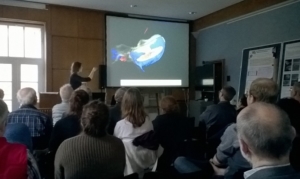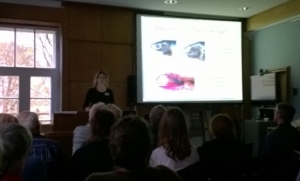| Das Epibranchialorgan des Milchfisches Chanos chanos (Gonorynchiformes) – Morphologie und phylogenetische Bedeutung
Josefine Vater1, 2; Matthias Mertzen1, 3 & Timo Moritz1, 3
1) Deutsches Meeresmuseum, Katharinenberg 14-20, 18439 Stralsund, Germany
2) Fachbereich Biologie, Chemie, Pharmazie Institut für Biologie, Schwendenerstr. 1, 14195 Berlin, Germany
3) Institut für Systematische Zoologie und Evolutionsbiologie, Erbertstr. 1, 07743 Jena Germany
Bei vielen Vertretern der basalen Teleostei, wie z.B. der Clupeiformes, Alepocephaloidei, Gonorynchiformes, Characiformes, Salmoniformes, Argentinoidei und Osmeroidei, wurden akzessorische Kiemenorgane beschrieben, die mit dem vierten und fünften Kiemenbogen assoziiert sind und der Konzentration von Nahrung dienen – die Epibranchialorgane. Häufig werden diese Epibranchialorgane als Autapomorphien für einzelne Taxa gewertet. Der Milchfisch Chanos chanos(Forsskål, 1775) ist die einzige rezente Art der Familie Chanidae in der Ordnung der Sandfischartigen (Gonorynchiformes). Am posterioren Ende seines Kiemenkorbes befindet sich ein besonders groß ausgeprägtes Epibranchialorgan. Es ähnelt von dorsal aus betrachtet einem auf dem Seite liegenden „J“. Es gibt zwei Öffnungen, die das Epibranchialorgan am vierten Kiemenbogen mit dem Kiemenraum verbindet. Das Lumen des Epibranchialorgans wird durch zwei Reihen Kiemenreusendornen in zwei Teile geteilt.
Zum Vergleich wurde der Aufbau der letzten beiden Kiemenbögen bei den Clupeiformes Engraulis encrasicolus, Nematalosa japonica und Denticeps clupeoides detailliert untersucht. Es zeigte sich, dass Epibranchialorgane sehr unterschiedlich ausgeprägt sein können. Während Chanos und Nematalosa sehr auffällige und hochspezialisierte Epibranchialorgane besitzen, findet sich bei Engraulis ein wenig spezialisiertes und kleineres Organ. Engraulis scheint weniger auf Filternahrung spezialisiert, kann diese Nahrung aber offensichtlich dennoch durch Hilfe des Organs erschließen. Der basalste Vertreter der Heringe, Denticeps, besitzt kein Epibranchialorgan, was bei seiner insektivoren Ernährung auch nicht überraschend ist. Doch finden sich an den letzten Kiemenbögen Hinweise, dass ein Epibranchialorgan möglicherweise einst vorhanden war und dann im Laufe der Evolution reduziert wurde.
Ein Vergleich der Epibranchialorgane von Chanos und den Clupeiformes deutet darauf hin, dass entsprechende Strukturen nochmals eingehend untersucht werden sollten, um Fragen der Homologie und Konvergenz zu klären. |


